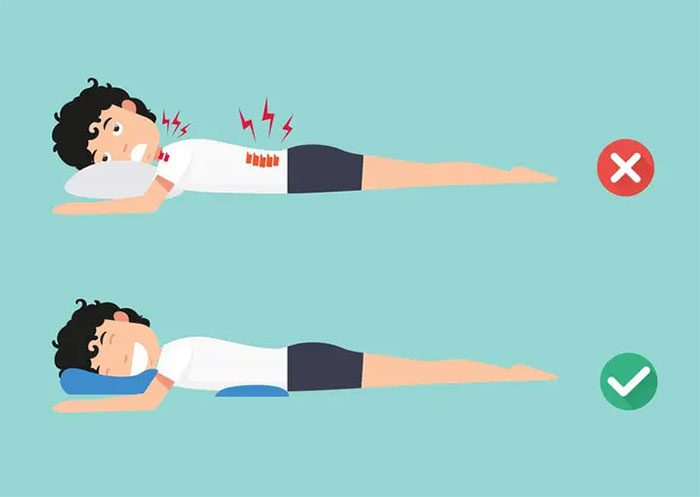In hotel rooms, there are usually 4 pillows on the bed, even though a maximum of only 2 people may be staying. Why is this the case, and do these pillows serve any purpose beyond supporting the head?
In hotels that adhere to international standards, we often see that on a bed meant for two people, there are always 4 pillows. They come in different shapes and sizes, typically large and small pillows alternating. The arrangement of multiple pillows is not excessive; each serves a specific purpose.
Reasons for 4 Pillows on Hotel Beds
In reality, this is not a random preparation but involves considerations regarding health. According to Sohu, most people tend to use the larger pillow for sleeping. The remaining pillows are not just for decoration; they have other functions.
Providing Guests with Options
Having 4 pillows on a bed meant for 2 people serves not only an aesthetic function but is also arranged with the health of the guests in mind, allowing them to choose what makes them most comfortable.
Typically, hotels provide a variety of pillows—high and low, soft and firm—to accommodate the sleeping habits of different individuals. With multiple pillows, guests can easily find one that suits them best for a restful and comfortable sleep. This is why there are 4 pillows on hotel beds.

Why are there 4 pillows on hotel beds? This is a question many people have. (Image: 3DExport).
Used as Back Support
In addition to sleeping, guests often lean against the headboard to read, watch their phones or TV, or engage in other activities. Generally, the headboard is quite hard, which can cause back pain; using additional pillows as support will enhance comfort.
Pillows for Perfect Sleeping Posture
Sleep occupies one-third of our lives, so posture during sleep should not be taken lightly. The right pillow is key to leading a person into restful sleep.
Medical studies indicate that using a pillow that is too high or too low can affect the spine. If the pillow is too high, you risk developing bone-related ailments, especially conditions like cervical spondylosis or spinal extension. If your chin is pushed down towards your neck, it means you’re using a pillow that’s too high.
If the pillow is too low and sinks deep behind your back, your head tends to tilt back. This position can lead to spinal misalignment and acid reflux during respiration.
According to scientists, to maintain the spine’s natural curvature, a pillow needs to support both the head and neck; additionally, another pillow should be placed under the legs to ensure muscle relaxation and optimal blood circulation.
The reason there are 4 pillows on hotel beds is primarily to safeguard guests’ health, preventing spinal deformities while ensuring a better night’s sleep.
With 4 pillows for 2 people in a hotel, individuals can use the large one for head support and the other for under their legs, facilitating blood circulation to all bodily organs. When turning over and lying on one side, the height needs to be doubled, and a pillow should also be placed between the legs. This pillow assists in movement and turning without causing pain or deformity.
Using Pillows Appropriately for Sleep Positions
For each sleeping position, you should use pillows in a way that’s suitable to ensure good health and quality sleep.
Sleeping on Your Back
When lying on your back, if the pillow is under your shoulders, it can put pressure on the cervical spine. Conversely, if only half of your head rests on the pillow, the cervical spine will be “suspended.” Both of these sleeping positions are inappropriate.
The best pillow for back sleepers should fill the gap between the neck and the mattress appropriately, creating a straight sleeping posture from the head, neck, to the spine. A thick pillow will elevate your head too high, causing the neck to curve upwards, potentially straining muscles, nerves, and discs. Conversely, a pillow that is too thin will cause your neck to bend uncomfortably.
A supportive and flexible pillow can prevent neck strain and misalignment. When lying on your back, gravity will pull your head towards the left or right shoulder. The right pillow will help keep your head in a relatively straight position, facing the ceiling. This reduces twisting of the neck.
Another pillow placed under both knees helps keep the knee joints bent and relaxed.

Using pillows correctly will lead to better sleep and health benefits. (Image: MPLC).
Sleeping on Your Side
Sleeping on your side is the most common sleeping position. It is an instinctual way to sleep and feels comfortable. Side sleepers usually prefer a higher (thicker) pillow.
When lying on your side, the pillow needs to be thick enough to keep the spine straight but not so thick that it causes neck distortion. Side sleepers will feel most comfortable on a pillow that is neither too soft nor too hard.
Experiments have shown that sleeping on a pillow with a height of 6-9 cm results in stable resting waveforms on an electroencephalogram, indicating the brain has entered a stable sleep state, resulting in the highest quality of sleep.
A pillow that is too high or too low can affect the natural curvature of the cervical and thoracic spine, potentially leading to cervical spondylosis and cerebrovascular diseases.
A pillow that is too high can also lead to respiratory issues such as snoring. Conversely, a pillow that is too low can cause blood vessels in the brain to become blocked during sleep, resulting in discomfort such as dizziness or bloating the next day.
Sleeping on Your Stomach
The stomach-sleeping position causes your head and spine to bend upwards unnaturally. Maintaining this position for hours is detrimental to your back or neck. Those who sleep on their stomachs need to use a much thinner pillow compared to back or side sleepers.
If you sleep on your stomach with a pillow that is too high, your spine will bend at an angle, increasing the likelihood of pain or numbness.




















































